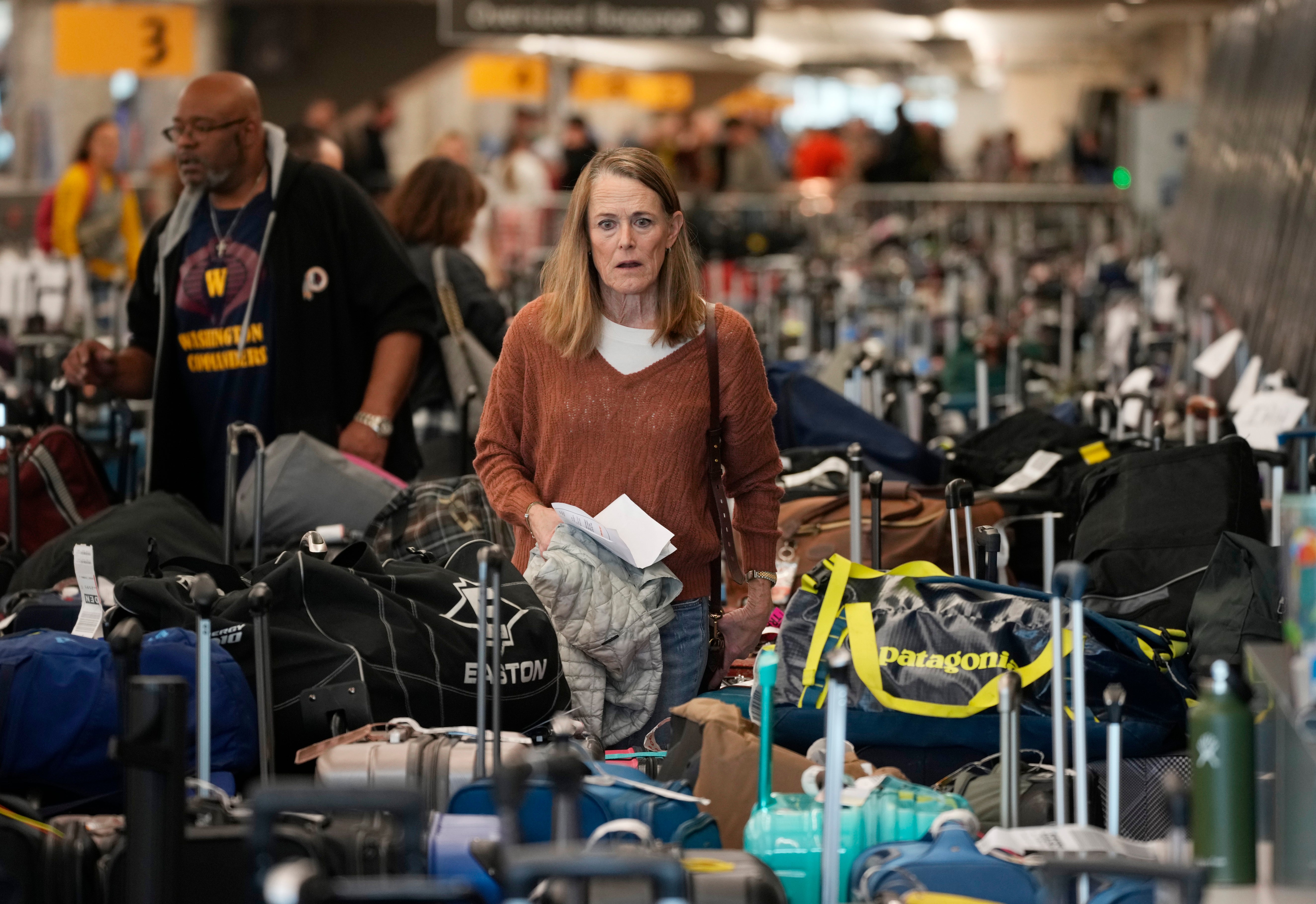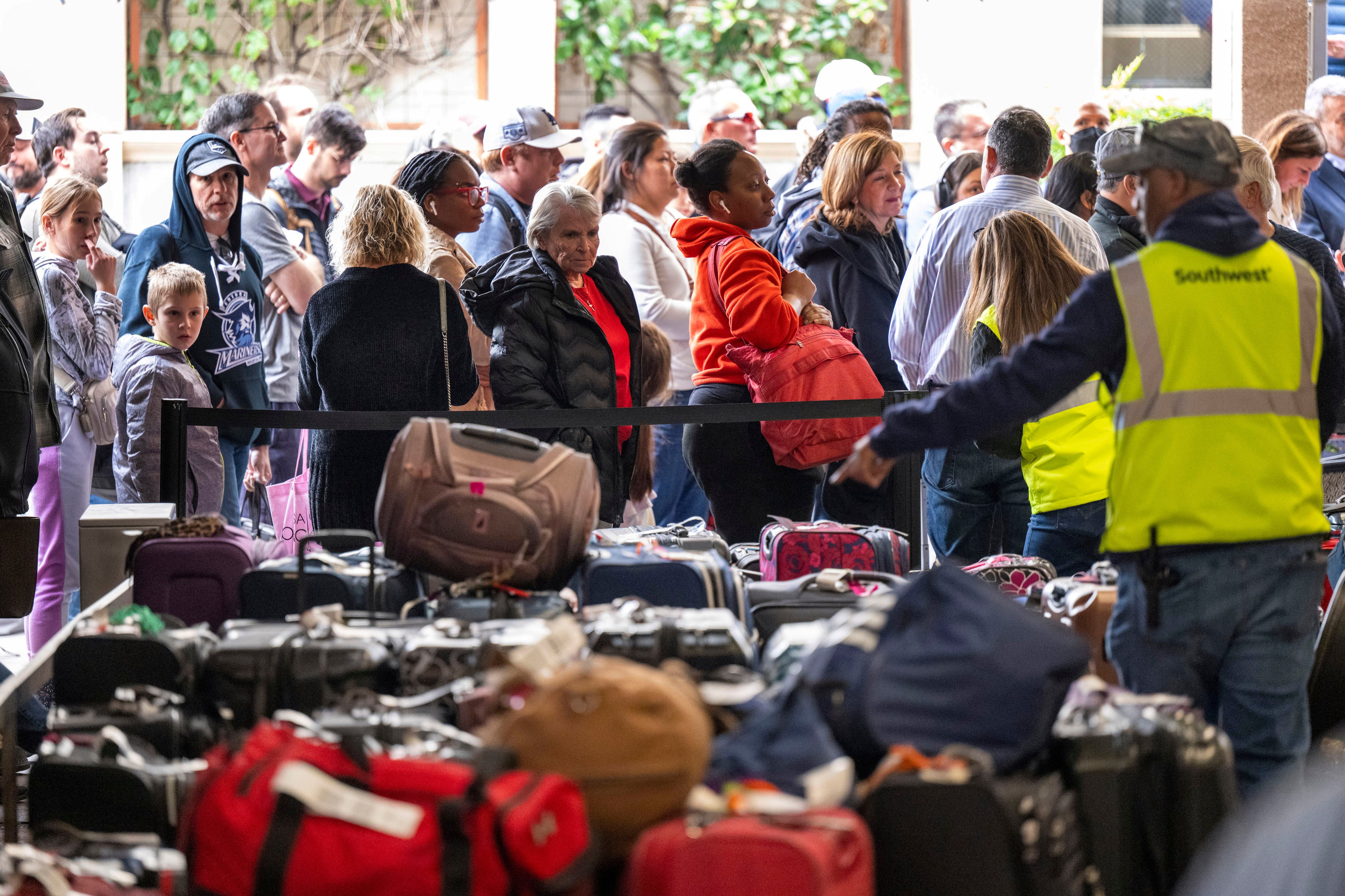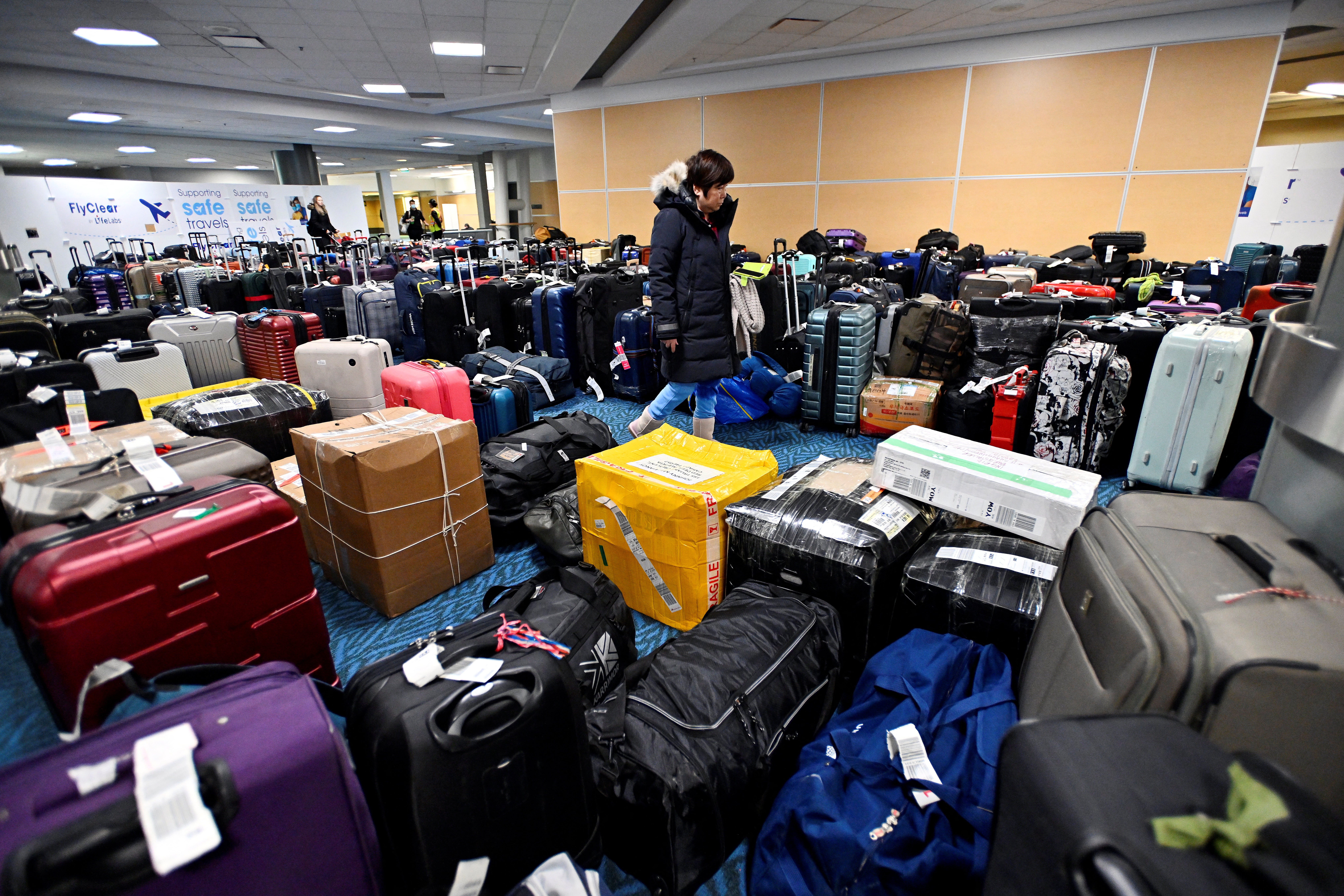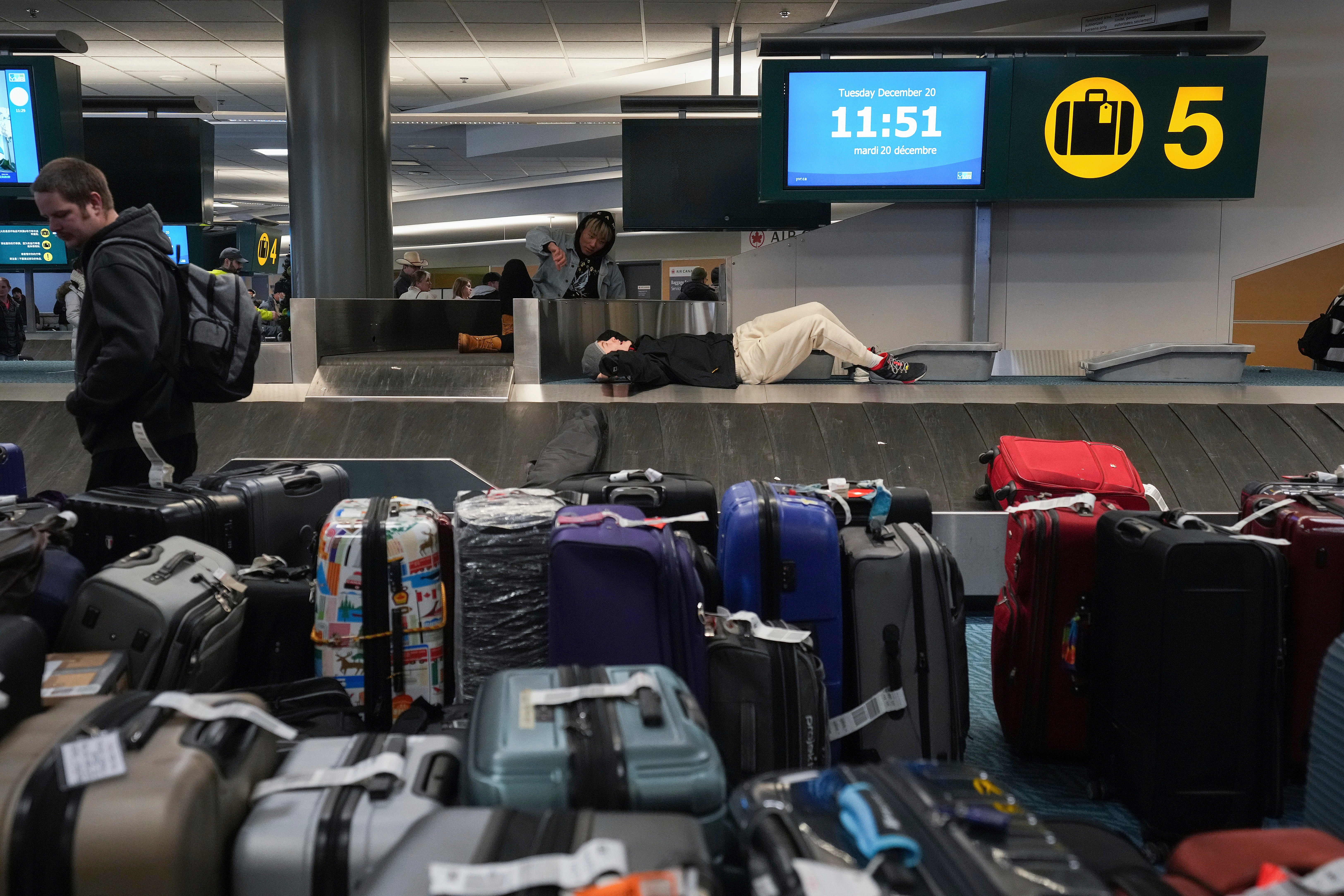What happens to lost luggage? US winter storms cap off nightmare year for travellers
Winter travel chaos wrought by Storm Elliott brings nightmarish end to difficult year for airline industry
North America was hammered by one of the worst snow storms in living memory this Christmas, with at least 72 people killed in the US and Canada by the astonishingly low sub-zero temperatures, which hit -40C in some areas.
Storm Elliott brought bitter winds, heavy snow and ice and caused transport chaos at one of the busiest times of the year for travel as thousands of flights were cancelled, cars were stranded and buildings left without power thanks to the most damaging spell of winter weather since the notorious Great Blizzard of 1977.
For the airline industry, the disaster proved to be the perfect end to a nightmare year.
The global air travel industry had hoped 2022 might mark a return to normality, with holidaymakers taking to the sky once again after two years of pandemic-related slowdown but has instead found itself beset with problems, to the point whereby lost and delayed luggage now appears to have become the norm.
Baggage troubles reached a fever pitch amid flight cancellations from the winter storms in North America, with images of airports packed with unclaimed luggage flooding social media. Those images do a decent job of summing up travel this year.
2022 - the year of lost luggage
This July, at the height of summer vacation season, more than six bags out of every 1,000 checked in by passengers were at least temporarily lost, according to data from the US Department of Transportation (DoT).
The number of delayed or lost bags rose to 0.64 per cent that month, up from 0.59 per cent in the same month in 2021.
During one especially memorable incident at London’s Heathrow Airport in June, thousands of suitcases and bags were pictured piled sky-high outside a terminal, in what was infamously dubbed “baggage mountain”.
That particular issue, at the world’s seventh-busiest airport, all started with a technical glitch in the baggage system at Terminal 2. This then resulted in a huge backlog of luggage stuck in transit, leaving baggage-handlers overwhelmed while trying to sort them out.
The Independent exclusively reported how Heathrow responded by asking airlines to cancel 10 per cent of their flights one day that month, so the transport hub could tackle the burgeoning problem. A staggering 15,000 passengers across 90 flights were estimated to be affected by the grounding of planes that day.
It was a meltdown that sparked one executive at Emirates to accuse the London airport of creating an “airmageddon”.

Meanwhile, Delta Air Lines took action by flying a plane (from London to Detroit) containing zero passengers but 1,000 lost bags in an effort to help reunite customers with their missing luggage.
Unsurprisingly, lost luggage complaints also skyrocketed this summer, with baggage being the number one cause of air travel complaints in July.
A staggering 1,842 complaints were lodged that month, more than eight times the 227 complaints received in July 2021, DoT data shows.
Such was the chaos that this year’s peak travel season earned the nickname “the summer of lost luggage”.
“This isn’t new. People have been losing luggage since the beginning of air travel,” Guillermo Ochovo, director of Cargo Facts Consulting, told The Independent.
Post-pandemic pains
But this year reached fresh crisis levels as the airline industry struggled to cope with the sudden surge in demand from travellers, he explained.
The airline industry was one of the hardest hit when Covid-19 spread across the globe and travel ground to a halt.
With borders closed and travel restrictions rumbling on, thousands of pilots, air stewards, ground handling staff and airport workers were all laid off.
Airlines also terminated or changed contracts with third-party suppliers – such as baggage-handling companies – as neither party was able to provide a service when no passengers were taking to the sky.
Now, travel has returned to almost pre-pandemic levels.
On 21 September, almost 2 million travellers passed through Transportation Security Administration checkpoints in the US – more than three times the amount of travellers (roughly 600,000) on the same day in 2020 and close to the 2.2 million travellers on the same date in 2019.
“Airlines have seen a strong surge in booking demand in the summer, and so they’ve rushed to add capacity and sell tickets,” said Mr Ochovo.
“After two years of losing money, airlines have started to see the light, with the lifting of travel restrictions and people wanting to get back to their holidays and travel again.”

While this is good news, Mr Ochovo said the industry wasn’t expecting such a rise in demand so quickly.
“The airlines did not anticipate this level of increased demand and they don’t have the resources in place to meet it,” he said.
“Thousands of people were laid off during the pandemic and so the main cause of the luggage crisis has been the lack of handling and ground staff at airports.”
As Mr Ochovo explained, while airlines have been launching major recruitment drives, baggage-handling companies are still grappling with staff shortages.
“There has been a big disconnection between airlines and their suppliers,” he said.
“Now there’s increased travel demand and not enough resources to meet it, as baggage-handling companies do not have enough staff to deal with problems when they arise.”
It’s not only a shortage in volume of baggage-handlers, but a loss of experience and skill set, said Gaylloyd Dadyala, chairman of the International Association of Baggage System Companies.
“By the time demand returned, people who were laid off had gotten other jobs and so the institutional knowledge that these people had had disappeared,” he told The Independent.
As the industry ramps up hiring, he said it is now “new hands on deck” trying to learn the ropes without having “the experienced hands to teach them the tricks”.
What happens to your bag behind the scenes?
Mr Dadyala described the baggage-handling system as a complex one that goes on behind the scenes of the passenger’s journey.
“Beneath the levels that the passenger sees is what I call a complex, industrial ballet taking place,” he explained.
“And when the industrial ballet is going to the right tune, things are going very well.
“But when something gets out of kilter that’s where experience comes in.”
Exactly how this “industrial ballet” goes wrong has long been a source of mystery for frustrated passengers who reach their destinations to find their bags didn’t make it.
So, how exactly does the baggage-handling system work?
What happens to your bag after you wave it off at the check-in desk?
At what stage can it all go wrong?
And where does your bag end up when it goes missing?

Behind the scenes of a passenger’s journey, their luggage is embarking on a far-flung journey all on its own.
It’s a journey that goes through three separate stages from the moment of check-in to the moment of arrival – with each stage adding an additional layer of complexity and opportunities for bags to go missing.
The first stage in the system is when the bag is moved from the check-in desk to the boarding gate.
Second comes the stage when the bag is moved from one gate to another during a transfer.
And the third and final stage is when the bag is moved from the arrival gate to the carousel at the end-destination airport.
During the first stage, the agent registers the luggage with the passenger’s name and travel itinerary at the check-in desk.
Tags and barcodes are printed and attached to the suitcase to connect the passenger and the bag.
Next, the bag is placed on a conveyor belt, and disappears from its owner’s sight.
As the passenger heads to the gate – to perhaps grab a pre-flight drink or a magazine before boarding the plane for take-off – the bag’s adventure really begins.
It passes through an automatic system that scans the bag’s barcodes to allocate it to an area of the baggage-handling conveyor that will send it on a path to the right gate.
Mr Ochovo estimated that around 85 per cent of barcodes are scanned automatically at this stage.
But, for the remainder, the barcode is unreadable, meaning human agents have to scan and sort them manually – opening up the first possibility of human error or delays in reaching the aircraft.
Once a bag has been scanned, a ground handler will then transport it to the gate and load it into the plane.
This is where the labour shortage presents another challenge, as there could be too many bags for the limited number of staff to process in time for take-off.
“If the automatic system isn’t working well or too many bags are not scanned automatically, the ground handler workers may not have enough time to scan them all manually and get them to the right plane on time,” Mr Ochovo said.
If a bag misses its flight, it’s possible it could end up in a country that doesn’t even feature on the passenger’s itinerary, he said.
This can happen when ground handlers place the bag on a new flight, with the aim of getting the luggage to the end destination in the quickest manner.
As airlines prioritise the luggage of passengers on upcoming flights, if the quickest, direct flight is fully booked, the best option may be to put the bags on a plane with a different airline or one that has a connecting flight in another country.
This adds an extra leg of the journey where something could go wrong.
At larger airports, airlines may have a choice of multiple baggage-handling companies they can work with at that hub. Likewise, the baggage-handlers at an airport will often be handling luggage for multiple airlines and multiple flights at any given time – further opening up opportunities for bags to be misplaced.
Let’s say the first stage went smoothly and the bag made it onto the same flight as its owner, travelling with them to the next destination but the passenger has a connecting flight to reach their end destination.
Now, this means the bag must also take that connecting flight.
This is where the second stage comes in, as the bag must be transferred from one gate to another.

Mr Ochovo said this adds “another level of complexity”, as it is doubling up the first process – in turn, doubling up the chances of the bag being mishandled.
It’s also likely different baggage-handling companies are operating at each of the airports the bag travels through.
“So, the chance to lose the bag increases,” said Mr Ochovo.
Provided the bag makes it onto the connecting flight, it enters the third and final stage of its journey: baggage collection.
As the bag reaches the end-destination airport, it is time to be reunited with its passenger.
Baggage-handlers unload all luggage from the aircraft and place it in an automatic system that scans the barcode again and directs the bag to the correct conveyor belt, so it can be picked up by its owner.
Once again, there could be an issue with the barcode and ground handlers may have to manually scan the bag.
Staff shortages could again lead to a delay in manually scanning, potentially resulting in the bag missing the limited time slot its flight had been allocated to use the airport conveyor belt. In that scenario, the bag may have reached the same destination as the customer and be in the same building – but they could still be unable to reunite.
At every one of these three stages of a journey, one of the big risks is that the barcode could be lost, damaged or unreadable, explains Mr Ochovo.
And, to further complicate things, the barcodes aren’t universally readable.
“If the bag ends up at the wrong airport and in the hands of the wrong airline, they might not be able to retrieve the information from the barcode,” said Mr Ochovo, pointing out that this is – in part – for data protection reasons for passengers.
“The barcodes are not universal but are usually specific to the airline... usually the airport and luggage system can read the final destination but not the passenger information.
“So, that’s why airports are often unable to tell passengers that their bags are there, if it’s in the wrong hands.”
If the passenger doesn’t know which airport a bag is at and the airport isn’t able to read the passenger details and contact them, reuniting bag and owner is next to impossible.
Where this lost luggage ultimately ends up is a “difficult question to answer”, said Mr Dadyala.
Airports need to keep their operational space clear, so often there are lost luggage offices or spaces designated to mishandled bags.
There, so many bags sit unclaimed and gather dust for months and years, leading some airports to hold auctions where buyers can bid for the items.
Ultimately, there is not a lot the passenger can do to prevent their luggage getting lost, said Mr Dadyala.
But he does offer some tips to try to narrow down the chances.
“Generally speaking, the challenge is going through a transfer hub,” he said.
Booking a direct flight, or at least avoiding a connecting flight where the transfer window is tight, can help avoid or reduce the risk of losing bags along the way.
Travelling off peak is also a good idea.
“The system and the handlers won’t have as much load at those times, so if there is an interruption to the industrial ballet, the handlers will have a bit more time to deal with it,” he said.
Given the key role the barcodes play in the chances of luggage being misplaced, Mr Ochovo also urges passengers to ensure they observe the agent placing two barcode stickers on two different places on their bags at the check-in desk.




Join our commenting forum
Join thought-provoking conversations, follow other Independent readers and see their replies
Comments